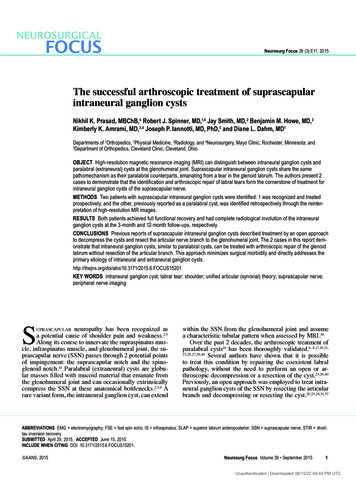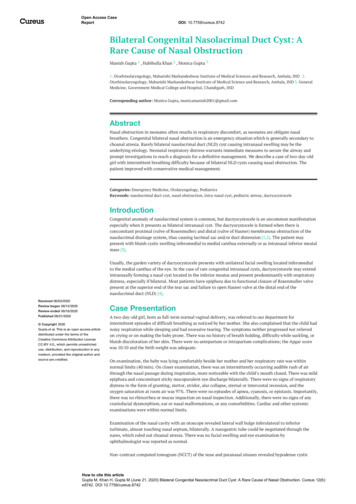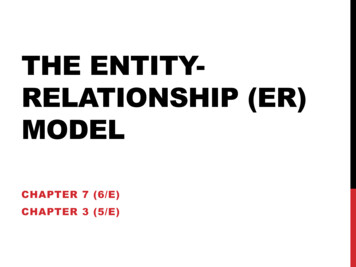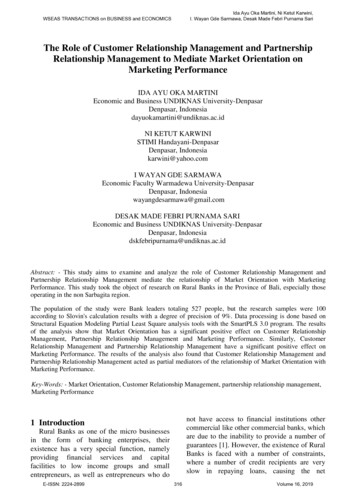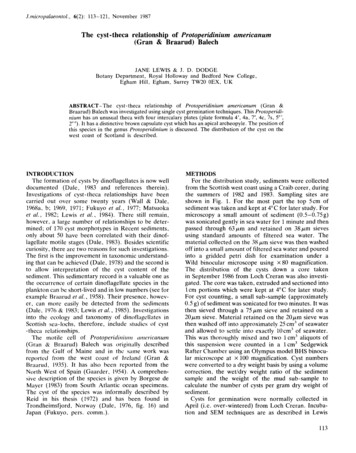
Transcription
J.micropalaeontol., 612): 113-121, November 1987-The cyst theca relationship of Protoperidinium americanum(Gran & Braarud) BalechJANE LEWIS & J. D. DODGEBotany Department, Royal Holloway and Bedford New College.Egharn Hill, Egham, Surrey TW20 OEX, UKABSTRACT-The cyst - theca relationship of Protoperidinium americanum (Gran &Braarud) Balech was investigated using single cyst germination techniques. This Protoperidinium has an unusual theca with four intercalary plates (plate formula 4', 4a, 7". 4c, 7s, S",2'"').It has a distinctive brown capsulate cyst which has an apical archeopyle. The position ofthis species in the genus Protoperidinium is discussed. The distribution of the cyst on thewest coast of Scotland is described.INTRODUCTIONThe formation of cysts by dinoflagellates is now welldocumented (Dale, 1983 and references therein).Investigations of cyst- theca relationships have beencarried out over some twenty years (Wall 24 Dale,1968a, b; 1969, 1971; Fukuyo et al., 1977; Matsuokaet al., 1982; Lewis et al., 1984). There still remain,however, a large number of relationships to be determined; of 170 cyst morphotypes in Recent sediments,only about 50 have been correlated with their dinoflagellate motile stages (Dale, 1983). Besides scientificcuriosity, there are two reasons for such investigations.The first is the improvement in taxonomic understanding that can be achieved (Dale, 1978) and the second isto allow interpretation of the cyst content of thesediment. This sedimentary record is a valuable one asthe occurrence of certain dinoflagellate species in theplankton can be short-lived and in low numbers (see forexample Braarud et al., 1958). Their presence, however, can more easily be detected from the sediments(Dale, I976 & 1983; Lewis et ul., 1985). Investig,'I t'ionsinto the ecology and taxonomy of dinoflagellates inScottish sea-lochs, therefore, include studies of cyst-theca relationships.The motile cell of Pvotoperidiriiirrir mnertcunum(Gran & Braarud) Balech was originally describedfrom the Gulf of Maine and in the same work wasreported from the west coast o f Ireland (Gran &Braarud, 1935). It has also been reported from theNorth West of Spain (Gaarder, 1954). A comprehensive description of the species is given by Borgese deMayer (1983) from South Atlantic ocean specimens.The cyst of the species was informally described byReid in his thesis (1972) and has been found inTrondheimsfjord, Norway (Dale, 1976, fig. 16) andJapan (Fukuyo, pers. comm.).METHODSFor the distribution study, sediments were collectedfrom the Scottish west coast using a Craib corer, duringthe summers of 1982 and 1983. Sampling sites areshown in Fig. 1. For the most part the top 5cm ofsediment was taken and kept at 4 C for later study. Formicroscopy a small amount of sediment (0.5-0.75g)was sonicated gently in sea water for 1 minute and thenpassed through 6 3 p m and retained on 3 8 p m sievesusing standard amounts of filtered sea water. Thematerial collected on the 38 p m sieve was then washedoff into a small amount of filtered sea water and pouredinto a gridded petri dish for examination under aWild binocular microscope using X 80 magnification.The distribution of the cysts down a core takenin September 1986 from Loch Creran was also investigated. The core was taken, extruded and sectioned intol c m portions which were kept at 4 C for later study.For cyst counting, a small sub-sample (approximately0.5g) of sediment was sonicated for two minutes. It wasthen sieved through a 7 5 p m sieve and retained on a20pm sieve. Material retained on the 20pm sieve wasthen washed off into approximately 25 cm3 of seawaterand allowed t o settle into exactly lOcm' of seawater.This was thoroughly mixed and two 1 cm3 aliquots ofthis suspension were counted in a l c m 3 SedgewickRafter Chamber using an Olympus model BHS binocular microscope at x 100 magnification. Cyst numberswere converted to a dry weight basis by using a volumecorrection, the wet/dry weight ratio of the sedimentsample and the weight of the mud sub-sample tocalculate the number of cysts per gram dry weight ofsediment.Cysts for germination were normally collected inApril (i.e. over-wintered) from Loch Creran. Incubation and SEM techniques are as described in Lewis113
Lewis & Dodge56’NFig. 1. Map of the west coast of Scotland showing the distribution ofProtoperidinium americanum. Circles denote stations sampled,indicates the presence of P. urnericanum in sediment sample. et al. (1984) with the additional use of a CambridgeSlOO and S410 scanning electron microscopes.OBSERVATIONSSome people have argued that a separate nomenclature should be retained for dinoflagellate cysts (see forexample, Reid, 1974 and Bradford, 1975). It is ourfeeling that this is unnecessarily complicated andartificial for dinoflagellate cysts belonging to extantspecies, where sufficient information is available to linkstages of the life-cycle (see also Dale, 1978). Althoughthis cyst species was informally described by Reid(unpub. thesis, 1972) as “Epidiniurn shugrinum”, it isproposed to describe it here under the name of itsmotile stage.114Division Pyrrophyta Pascher, 1914Class Dinophyceae Fritsch, 1929Order Peridiniales Haeckel, 1894Family Peridiniaceae Ehrenberg, 1832Genus Protoperidinium Bergh, emend. Balech, 1974Protoperidinium arnericunurn (Gran & Braarud)Balech(PI. 1, figs. 1-8; P1. 2, figs. 1-6; Fig. 2a-e)Dimensions. Theca: 30-40 p m long, 28-38 Fm wide; 7specimens measured. Cyst: 35-52 p m across; 20 specimens measured.Description of cysts. Cysts of this species are very easilyrecognised. They are capsulate and pale brown incolour. Before excystment they have the typical Protoperidiniurn contents of numerous pale droplets (Pl. 1,
Cyst-theca relationship of Protoperidinium americanumfig. 1). The endocyst is spherical. The thick-walledendophragm is composed of two parts, the inner layeris smooth and is overlain by the granular outer layer(Pl. 1, figs. 6, 8). The periphragm is thin, smooth andclear and it fits loosely around the endocyst, in placesbeing pressed close to the endophragm and in othersgently folded away (PI. 1, fig. 5 ) . The folds are notrelated to any paratabulation, indeed, aside from thearcheopyle no paratabularion was evident in thegeneral morphology of the cyst.The archeopyle is unusual for the genus and isdifferent in the endocyst and the pericyst. The endoarcheopyle is compound polyplacoid (PI. 1, fig. 4) beingcomposed of three opercular pieces which appear torepresent the loss of the second, third and fourth apicalparaplates (Fig. 2c). These opercular pieces mayremain protuding outwards shortly after excystment(Pl. 1, fig. 3) but they are quickly lost thereafter. Insome cases these opercular pieces were seen to havefallen into the cyst. In some specimens that had notexcysted but where the contents had decomposed, theprincipal and accessory archeopyle sutures surroundingeach opercular piece were clear. The periarcheopyle issomewhat variable. This, however, may be a secondaryeffect caused by the thinness of the periphragm whichmakes it prone to splitting and tearing after excystment. In several specimens, a clear three-way split hasbeen found (Pl. 1, fig. 7) and this possibly is the truearcheopyle. This split may represent the parasuturesbetween the apical paraplates, 2', 3'. and 4. but in thespecimens where this was observed it was not possibleto check the orientation of the splits with the endoarcheopyle. Following Evitt (1985). the archeopyle formula is ?/3A2-4.4'edFig. 2. Line drawings of Protoperidiizium americanum, those of thecate cell taken from scanning micrographs ofseven specimens, that of the cyst taken from light micrographs of eight specimens.Hypothecal tabulation.Epithecal tabulation.Endocyst depicting archeopyle (apical view). Dotted lines denote accessory archeopyle sutures separatingthe opercular pieces.Sulcal tabulation. Shading represents sulcal wing situated between the Sd and Sm plates. The smallunmarked plate at the base of the Sm plate is the Spa plate, that at the top of the plate is the Sdi plate.Apical tabulation.115
Lewis & DodgeLike many Protoperidinium cysts, that of Protoperidinium americanum is not robust and empty specimensfrom the sediments were frequently found to beflattened. Occasional specimens were noted withoutthe periphragm.Description of thecae. Some 25 thecate motile cells havebeen obtained from successful incubations. They frequently rounded off after excystment and did notproperly form their theca (PI. 1, fig. 2). Cells lackedchloroplasts but contained some pale green bodies. Thecells are nearly spherical, being slightly longer thanwide. The theca is very delicate making plate determination difficult. Plates are smooth with slight undulations which are most noticeable on the hypotheca (PI.2, fig. 3). The trichocyst pores are simple holes with aninset ‘canon’-like structure (Pl. 2, fig. 7); they arescattered over the plates and were often found in rowsalong the plate margins (Pl. 2, figs. 4, 5 ) . The girdle ismedian, very slightly offset and excavated with no listand, apart from the trichocysts, there is no girdleornament (Pl. 2, fig. 1). It consists of four cingularplates.The apical pore structure consists of a cover plate(’p0)with a ridge surrounding a tiny pore plate (PI. 2,fig. 6; Fig. 2e). In most specimens this tiny pore platehad been lost (PI. 2, figs. 2, 7). A near rectangularcanal plate joins the pore plate to the somewhatasymmetrical first apical plates (PI. 2, figs. 6, 7). Themost striking feature of the plate structure of thisorganism are the four intercalary plates (Pl. 2, Figs. 2,4). The sulcus is large and indented, reaching theantapex of the cell (PI. 2, fig. 5 ) . The Sp plate is largerthan is usual in Protoperidinium species (PI. 2,fig. 3;Fig. 2b). There is a small sulcal wing situated betweenthe Sd and Sm plate (Fig. 2d). Aside from theintercalary plates, the plate formula was as for a typicalProtoperidinium: - 4’, 4a, 7”, 4c, 7s, 5”’, 2”’’.In all respects this description, made with the aid ofscanning electron microscopy, tallies with the detailedone given by Borgese de Mayer (1983).Distribution. The cyst was found in core samplesmarked in Fig. 1. The highest cyst numbers were foundin Lochs Creran and Melfort but these lochs were themost extensively studied (for further details see Lewis,1985). In addition to the sampling sites shown in Fig. 1,three more northerly lochs were sampled, Lochs Nevis,Hourn, and Torridon. Cysts were found to be presentin Loch Torridon. Counts of the sectioned core fromCreran showed an increase in total cyst numbers(empty and full cysts) from the top of the core to thebottom (from 1,376 cysts per gram dry weight ofsediment in the top l c m to 2,175 cysts per gram dryweight of sediment in the 14cm section).The thecate cell was never noted in phytoplanktonsamples from the sites of the distribution study or inLoch Creran during a two year seasonal study of thedinoflagellates.DISCUSSIONReid (1972), in his investigation of dinoflagellate cystsaround the British Isles, found P. americanum mostcommonly,on the west coast of Scotland. It was alsopresent on the east coast of Scotland and aroundIreland but was absent from the English Channel andthe Bristol Channel. In this study the P. americanumcyst was found in most of the sea-lochs sampled and itsExplanation of Plate 1Cyst of Protoperidinium americanumFig. 1. Light micrograph of whole cyst from 14cm section of Loch Creran depth distribution sampled, 2287. 36pmacross.Fig. 2. Light micrograph of germinated cyst, in this case the ‘gymnodinioid’ cell did not survive but rounded off, thecell 30pm long, cyst from Loch Creran sediment sample, 268.Fig. 3. Light micrograph of excysted cyst showing three separate opercular pieces. Cyst 52pm across, from LochCreran sediment sample, 2154.Fig. 4. Light micrograph of empty cyst showing archeopyle of the inner wall, cyst 40pm across from Loch Creransediment sample, 2283.Fig. 5. S E M of whole cyst from Loch Creran sediment sample, cyst 37pm across.Fig. 6. Empty cyst showing split in outer wall layer and the archeopyle of the inner layer, cyst 37pm across.Fig. 7. Empty cyst showing three way split in the outer wall. Cyst from Loch Creran sediment snmplc, 38pm across.Fig. 8. Empty cyst, showing two layer structure of the inner wall. Cyst from Loch Creran sediment sample( x 10,000).116
Cyst- theca relationship of Protoperidinium americanum117
Lewis & Dodgeabsence in other samples is most likely due to thegeneral paucity of cysts in those samples (for example,samples from the Sound of Jura). From the otherscattered reports of the thecate stage and the cyst, thisspecies would appear to have a fairly widespreadcoastal distribution although it is rarely seen in theplankton (Gran & Braarud, 1935; Gaarder, 1954;Borgese de Mayer, 1983; Dale, 1976). Despite extensive counting of the thecate dinoflagellates from watersamples from the west coast of Scotland, this specieshas never been noted (Lewis, 1985). This is possiblybecuase of confusion with other species or could be dueto its rarity in the water column. The distribution ofProtoperidinium americanum is clearly most easilydiscerned by examining bottom sediments. This speciesdoes not appear to have been described from the fossilrecord but as it is fairly delicate, it would probably notpreserve well. However, it is perhaps surprising that itwas not noted in Harland’s distribution survey ofRecent dinoflagellate cysts which did record manyother Protoperidinium species (Harland, 1983).The structure of this cyst is somewhat atypical of theRecent marine Protoperidinium cysts thus far known,none of which are capsulate or have apical archeopyles.The most similar marine cyst is Dubridinium caperatumReid which was established as the cyst of Diplopeltopsisminor (Paulsen) Pavillard [ Zygabikodinium lenticulatum (Paulsen) Loeblich & Loeblich 1111 by Wall 8r.Dale (1968a). In D. caperatum, however, the walllayers are closely associated, the archeopyle is epicystaland there is also some paratabulation. There are,however, a number of Recent capsulate freshwatercysts, for example Peridinium limbatum (Stokes) Lemmermann, investigated by Evitt & Wall (1968) andPeridinium wisconsinense Eddy, investigated by Wall &Dale (1968a) but these differ from Protoperidiniumamericanum in having apical and antapical horns, in thepresence of paratabulation and in their archeopyles.The archeopyle of P. wisconsinense is the most similar,being apical and representing the loss of 2’, 3’, 4’, andpart of 1’. It does, however, remain attached ventrallyand the paraplates do not separate. The archeopyle ofP. limbatum is transapical (Wall & Dale, 1968a; Evitt &Wall, 1968). Perhaps the most similar of these freshwater cysts is cyst type D of Norris & McAndrews (1970),it being more rounded than the previous two. Otherfreshwater Peridinium cysts appear to have three walls,for example Peridinium cinctum f . ovoplanum Lindemann (Pfeister, 1975) and Perdinium willei HuitfieldKass (Pfeister, 1976). The P. americanum cyst wouldseem to be most closely related to the two-walledfreshwater cysts.The archeopyle is interesting as it differs considerably from the intercalary archeopyles typical of otherProtoperidinium species. It does not fit in with any ofthe peridinioid archeopyle types surveyed by Evitt(1985). A 3A archeopyle is, however, figured for anon-peridinioid cyst (fig. 6.9 H) so this type is notunique. The difference in archeopyle in the endophragm and the periphragm indicates that the twowalls are structurally independent, fitting into thescheme described by Eaton (1984) for fossil cavatecysts.The arrangement of the plates of the epitheca andthe cingulum are also somewhat atypical for the genus.In Protoperidinium, there are normally two or threeintercalary plates. The fourth intercalary plate appearsto be unique to this species. The first intercalary (la)could perhaps be regarded as the extra one with respectto the rest of the genus (Fig. 2a). It is unusual in that ittouches the first precingular plate (iff), an arrangementfound within the genus Peridinium (Peridinium aciculiferum (Lemmermann) Lemmermann in Bourrelly ,1970) but not Protoperidinium. The genus Peridinium,however, does seem to have much less conservativeepithecal plate arrangements. The cingular plates,although the same in number as other members of thegenus, are different in arrangement. The first cingularExplanation of Plate 2SEM illustrations of excysted thecate cells of Protoperidinium americanumFig. 1. Ventral view, cell approximately 3Spm across.Fig. 2. Apical view of cell in fig. 1, cell approximately 35pm across.Fig. 3. Antapical view, cell approximately 35pm across.Fig. 4. Ventral/apical view showing first intercalary plate, cell approximately 30pm across.Fig. 5 . View of sulcus(X4,000).Fig. 6. Apical pore showing tiny pore plate in the centre(X9,900).Fig. 7. Detail of apical pore and trichocyst pores. The outer cell membrane (normally strippcd away during S E Mprocessing) is still present in the bottom left hand corner of the picture ( X 11,500).118
Cyst - theca relationship of Protoperidinium americanum119
Lewis & Dodgeplate (lc or the T plate of some authors, e.g. Balech,1974) is much longer than is usual, running from thesulcus, past the first precingular (1”) plate and part wayinto the second precingular (2”) plate (Fig. 2b). In otherProtoperidinium species, this area is usually occupiedby the first two cingular plates. Consequently, the verylarge third cingular plate (3c) of other Protoperidiniumspecies is replaced by the second and third cingulars inthis species; an arrangement analagous to that found inPeridinium.P. americanum clearly has some affinities withPeridinium but differs in the number of cingular platesand the lack of chloroplasts. Nevertheless, it is a uniquemember of the genus Protoperidinium. The cyst isatypical in both the archeopyle and general morphology and with the difference in thecal plate tabulation,this raises the question of the position of this species inthe genus. However, as at present only one species ofthis type is known, we feel that any taxonomic revisionsshould wait for further examples.An additional problem is that of dual nomenclature.While with fossil species there is a clear need for aseparate nomenclature, the case for such a dualnomenclature for Recent cysts is not so clear cut.However, with P. americanum the link between the cystand the thecate stage has been clearly established andeach completely described. As Dale (1978, p. 192)concluded, “New cyst-based nomenclature should notbe created just to ‘artificially’ maintain dual classification” and Reid (1974, p. 587) also suggested that the“thecate stage should take precedence for nomenclatural purposes”. In conclusion, we feel this cyst should beknown as the “cyst of I? americanum” as is the case forsome other Recent cysts (for example P. Zimbatum andP. wisconsinense; Evitt, 1985).ACKNOWLEDGEMENTSThe distribution work was carried out whilst JL wasin receipt of a N.E.R.C. CASE studentship with theScottish Marine Biological Association. Thanks go tothe S.M.B.A. for further field sampling facilities sincethat time. The remainder of the work was carried outunder N.E.R.C. grant no. GR3/5511.Manuscript received March 1987Revised manuscript accepted August 1987120REFERENCESBalech, E. 1974. El genero “Protoperidinium” Bergh, 1881(“Peridinium” Ehrenberg, 1831, Partim). Rev. Mus. Cienc.natur., Hidrobiol., IV, ( l ) , 1-79, figs. I-XXXI.Borgese de Mayer, M. B. 1983. Un Protoperidinium detabulacion atipica y neuvo para el hemisferio sur (Dinoflagellata). Subsecretaria de estado de ciencia y tecnologiaconsejo nacional de investigaciones cientificas y tecnicascentro nacional, Peurto Madryn Chubut, 71, 1-8, figs.1-17.Bourrelly, P. 1970 Les algues d’eau douce. Intitiation a lasystematiques. Collection “faunes et flores actuelles” Tome111: Les Algues bleues et rouges Les EuglCniens, PCridiniens et Crytomonadines. 512pp. BoubCe, Paris.Braarud, T., Foyn, B. & Hasle, G. R. 1958. The marine andfresh-water phytoplankton of the Dramsfjord and theadjacent part of the Oslofjord, March-December 1951.Hvalrdd. Skr., Oslo, 43, 3-102.Bradford, M. R. 1975. New dinoflagellate cyst genera fromthe recent sediments of the Persian Gulf. Can. J . Bot.,Ottawa, 53, 3064-3074, figs. 2-28.Dale, B. 1978. Cyst formation, sedimentation, and preservation: factors affecting dinoflagellate assemblages in Recentsediments from Trondheimsfjord, Norway. Rev.Palaeobot. Palynol., Amsterdam, 22, 39-60, figs. 1-3, 1PI.Dale, B. 1978. Acritarchous cysts of Peridinium faeroensePaulsen: Implications for dinoflagellate systematics. Palynology, Dallas, 2, 187-193, figs. 1-2.Dale, B. 1983. Dinoflagellate resting cysts: “benthic plankton”. In Fryxell, G. A . (Ed.), Survival strategies of thealgae, 69-136, figs. 1-46, Cambridge University Press.Eaton, G. L. 1984. Structure and encystment in some fossilcavate dinoflagellate cysts. J . micropalaeontol., London, 3,53-64, figs. 1-5, pls. 1-2.Evitt, W. R. (1985). Sporopollenin Dinoflagellate cysts, theirmorphology and interpretation, xv 333pp. Amer. Assoc.Strat. Palynol. Found.Evitt, W. R. & Wall, D. 1968. Dinoflagellate studies IV.Theca and cyst of Recent freshwater Peridinium limbaturn(Stokes) Lemmermann. Stanford Univ. Publs., Geol. Sci.,Palo Alto, XII, (2), 1-15, pls. 1-4.Fukuyo, Y., Kittaka, J. & Hirano, R. 1977. Studies on thecysts of marine dinoflagellates I. Protoperidinium minutum(Kofoid) Loeblich. Bull. Plankton SOC.Japan, 24, 11-18,In Japanese with English abstract.Gaarder, K. R. 1954. Dinoflagellatae from the “MichaelSars” North Atlantic Deep Sea Expedition, 1910. Rept. Sci.results of the Michael Sars North Atlantic Deep sea exped.1910, Bergen, I1 (3), 77 figs.Gran, H. H. & Braarud, T. 1935. A quantitative study of thephytoplankton in the Bay of Fundy and the Gulf of Maine(including observations on hydrography, chemistry andturbidity). J . Biol. Bd. Can., 1, 279-467.Harland, R. 1983. Distribution maps of recent dinoflagellatecysts in bottom sediments from the North Atlantic oceanand adjacent seas. Palaeontology, London, 26, 321-397,figs. 1-44, pls. 43-48.Lewis, J. M. 1985. The ecology and taxonomy of marinedinoflagellates in Scottish sea-lochs. Unpub. PhD thesis,University of London.
Cyst-theca relationship of Protoperidinium americanumLewis, J., Dodge, J. D. & Tett, P. 1984. Cyst-thecarelationships in Protoperidinium species (Peridiniales)from Scottish sea lochs. J . micropalaeontol., London, 3,25-34, figs. 1-2, pls. 1-2.Lewis, J., Tett, P. & Dodge, J. D. 198.5. The cyst-theca cycleof Gonyaulax polyedra (Lingulodinium machaerophorum)in Creran, a Scottish west coast seas-loch. In Anderson,D. M., White, A. W. & Baden, D. (Eds.), Toxicdinoflagellates, 85-90, Elsevier Science Publishing Co.,Inc.Matsuoka, K., Kobayashi, S. & Iizuka, S. 1982. Cysts ofProtoperidinium divaricaturn (Meunier) Parke et Dodge1976 from surface sediments of Omura Bay, West Japan.Rev, Palaebot. Palynol., Amsterdam, 38, 109-118, figs.1-2, PIS. 1-2.Norris, G. & McAndrews, J. H. 1970. Dinoflagellate cystsfrom post-glacial lake muds, Minnesota (U.S.A.). Rev.Palaeobot. Palynol. Amsterdam, 10, 131-156, figs. 1-5,PIS. 1-3.Pfeister, L. A. 1975. Sexual reproduction of Peridiniumcinctum f . ovoplanum (Dinophyceae). J . Phycol., Lawrence, Kansas, 11, 259-265, figs. 1-3.Pfeister, L. A. 1976. Sexual reproduction of Peridinium willei(dinophyceae). J . Phycol., Lawrence, Kansas, 12, 234238, figs. 1-13.Reid, P. C. 1972. The distribution of dinoflagellate cysts,pollen and spores in Recent marine sediments f r o m theBritish Isles. Unpub. PhD. thesis, University of Sheffield.Reid, P. C. 1974. Gonyaulacacean dinoflagellate cysts fromthe British Isles. Nova Hedwigia, Stuttgart, XXV, 579-637,figs. 1-4, pls. 1-4.Wall, D. & Dale, B. 1968a. Modern dinoflagellate cysts andevolution of the Peridiniales. Micropaleontology, NewYork, 14, 265-304, figs. 1-7, pls. 1-4.Wall, D. & Dale, B. 1968b. Quaternary calcareous dinoflagellates (Calciodineliideae) and their natural affinities. J.Paleontology. Tulsa, 42, 1395-1408, figs. 1-3, pl. 172.Wall, D. & Dale, B. 1969. The “hystrichosphaerid” restingspore of the dinoflagellate Pyrodiniuni bahamense, Plate,1906. J . Phycol., Lawrence, Kansas, 5, 140-149, figs.1-34.Wall, D. & Dale, B. 1971. A reconsideration of living andfossil Pyrophacus Stein, 1883 (Dinophyceae). J. Phycol.,Lawrence, Kansas, 7, 221-235, figs. 1-40.12 1
The motile cell of Pvotoperidiriiirrir mnertcunum (Gran & Braarud) Balech was originally described . For cyst counting, a small sub-sample (approximately 0.5 g) of sediment was sonicated for two minutes. It was . this suspension were counted in a lcm3 Sedgewick Rafter Chamber using an Olympus model BHS binocu- lar microscope at x 100 .


